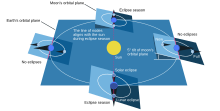축선 평행도
Axial parallelism
축선평행성( axial線平行性, )은 물체가 공간을 이동할 때 회전축의 방향이 고정된 상태로 유지되는 회전체의 특징입니다.천문학에서, 이 특징은 궤도에 있는 천체에서 발견됩니다.이것은 자이로스코프의 회전축이 지구가 회전할 때 일정하게 유지되도록 하여 그 장치들이 지구의 회전을 측정할 수 있도록 하는 것과 같은 효과입니다.[1]
예
지구의 축선 평행선

지구의 궤도는 축이 23.5도로 기울어져 있으며, 일년 내내 북극성("북극성")을 향해 방향을 유지하면서 대략적인 축선 평행성을 보여줍니다.지구의 축 방향 기울기와 함께, 이것은 오른쪽 도표로 보여지듯이 지구의 계절에 대한 주요한 이유 중 하나입니다.[2][3][4][5]이것은 별들이 지구가 태양을 도는 궤도 전체에 걸쳐 "고정된" 극 별과 같이 밤하늘에 고정되어 보이는 이유이기도 합니다.[6]
축의 방향의 작은 변화, 즉 축의 세차운동은 26,000년에 걸쳐 일어납니다.그 결과 앞으로 11,000년 동안 지구의 축은 북극성이 아닌 베가 쪽으로 움직일 것입니다.[7]
기타 천문학적 예


축선 평행성은 천문학에서 널리 관찰됩니다.예를 들어, 달의 궤도면의[8] 축방향 평행성은 일식 현상의 핵심적인 요소입니다.달의 궤도축은 18년, 10일의 사로스 주기 동안 완전한 원을 그리게 됩니다.달의 궤도 경사가 황도 경사와 정렬되어 있을 때는 황도에서 29도인 반면, 반정렬일 때(9년 후)는 궤도 경사가 18도에 불과합니다.
게다가, 토성의 고리는 그 행성이 태양 주위를 돌면서 고정된 방향으로 유지됩니다.[9]
설명.
초기의 자이로스코프는 원리를 증명하기 위해 사용되었는데, 가장 주목할 만한 것은 푸코의 자이로스코프 실험이었습니다.[10]자이로스코프가 발명되기 전에는 과학자들에 의해 다양한 방법으로 설명되어 왔습니다.[9]아이작 뉴턴과 동시대의 천문학자 데이비드 그레고리는 다음과 같이 썼습니다.
위치에 주어진 적절한 축에 대한 천체의 움직임과 회전에 대한 설명... 만약 어떤 물체가 주어진 축에 대해 움직이고 있다고 한다면, 다른 측면에서 보면, 축이 수직인 원에 대해 설명하기 위해 그 물체는 움직이지 않아야 하고, 모든 점에서 축이 수직인 원에 대해 설명해야 합니다.그리고 그러한 이유로, 만약 한 몸이 선을 따라 운반되고, 동시에 주어진 도끼에 대해 회전한다면; 도끼는, 몸이 움직이는 모든 시간에 있어서, 자신과 평행하게 계속될 것입니다.또한 이 평행성을 유지하기 위해 필요한 것은 이 두 가지 외에 다른 움직임이 신체에 감명을 받지 않는 것 외에는 없습니다. 만약 그 안에 다른 세 번째 움직임이 없다면, 그 도끼는 한 때 평행했던 오른쪽 선에 항상 평행하게 계속될 것이기 때문입니다.[11]
이 자이로스코프 효과는 현대에는 "자이로스코프 강성" 또는 "우주의 강성"으로 설명됩니다.뉴턴의 역학적 설명은 각운동량의 보존으로 알려져 있습니다.[12]
참고 항목
참고문헌
- ^ Kumar, B.; DeRemer, D.; Marshall, D. (2005). An Illustrated Dictionary of Aviation. McGraw-Hill Education. p. 326. ISBN 978-0-07-139606-6. Retrieved 2022-12-03.
Because of rigidity in space, a gyroscope does not tilt its axis of rotation as the earth rotates.
- ^ Petersen, J.; Sack, D.; Gabler, R.E. (2014). Fundamentals of Physical Geography. Cengage Learning. p. 18. ISBN 978-1-285-96971-8. Retrieved 2022-12-02.
- ^ The Popular Educator. John Cassell. 1856. p. 89. Retrieved 2022-12-02.
- ^ Oliver, J.E. (2008). Encyclopedia of World Climatology. Encyclopedia of World Climatology. Springer Netherlands. p. 651. ISBN 978-1-4020-3264-6. Retrieved 2022-12-02.
- ^ Rohli, R.V.; Vega, A.J. (2011). Climatology. Jones & Bartlett Learning, LLC. p. 30. ISBN 978-1-4496-5591-4. Retrieved 2022-12-02.
- ^ Lerner, K. Lee; Lerner, Brenda Wilmoth (2003). World of earth science. Farmington Hills, MI: Thomson-Gale. p. 487. ISBN 0-7876-9332-4. OCLC 60695883.
Although these distances seem counterintuitive to residents of the Northern Hemisphere who experience summer in July and winter in January—the seasons are not nearly as greatly affected by distance as they are by changes in solar illumination caused by the fact that Earth's polar axis is inclined 23.5 degrees from the perpendicular to the ecliptic (the plane of the solar system through or near which most of the planet's orbits travel) and because the Earth exhibits parallelism (currently toward Polaris, the North Star) as it revolves about the Sun.
- ^ Lerner, K. Lee; Lerner, Brenda Wilmoth (2003). World of earth science. Farmington Hills, MI: Thomson-Gale. p. 105 and 454. ISBN 0-7876-9332-4. OCLC 60695883.
During revolution about the Sun, the earth's polar axis exhibits parallelism to Polaris (also known as the North Star). Although observing parallelism, the orientation of Earth's polar axis exhibits precession—a circular wobbling exhibited by gyroscopes—that results in a 28,000-year-long precessional cycle. Currently, Earth's polar axis points roughly in the direction of Polaris (the North Star). As a result of precession, over the next 11,000 years, Earth's axis will precess or wobble so that it assumes an orientation toward the star Vega.
- ^ Gravesande, W.J.; Desaguliers, J.T.; Newton, I. (1726). Mathematical Elements of Natural Philosophy Confirmed by Experiments, Or An Introduction to Sir Isaac Newton's Philosophy ... Translated Into English by J. T. Desaguliers ... The Second Edition, Carefully Review'd and Corrected by the Translator. p. 184. Retrieved 2022-12-03.
The Axis of the Moon is not perpendicular to the Plane of its Orbit, but a little inclin'd to it: The Axis keeps its Parallelism in its Motion round the Earth
- ^ a b Ferguson, J. (1673). Astronomy Explained Upon Sir Isaac Newton's Principles ... A New Edition, Corrected. [With Plates.]. W. Strahan. p. 189. Retrieved 2022-12-02.
- ^ The Encyclopaedia Britannica: A Dictionary of Arts, Sciences and General Literature. R.S. Peale. 1890. p. 351. Retrieved 2022-12-02.
Under the title of precession instruments, various pieces of apparatus, involving the gyroscope principle, have been in use for a number of years for illustrating the precession of the equinoxes, and the parallelism of the earth's axis as it revolves round the sun.
- ^ Gregory, D. (1715). The Elements of Astronomy, Physical and Geometrical. By David Gregory ... Done Into English, with Additions and Corrections. To which is Annex'd, Dr. Halley's Synopsis of the Astronomy of Comets . J. Nicholson ... sold. p. 59. Retrieved 2022-12-02.
- ^ Giordano, N. (2012). College Physics: Reasoning and Relationships. Cengage Learning. p. 299. ISBN 978-1-285-22534-0. Retrieved 2022-12-02.


